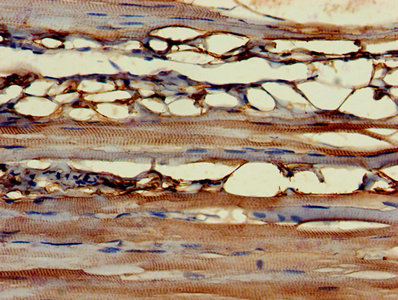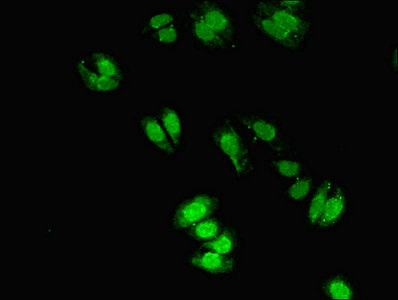CYGB Antibody
-
货号:CSB-PA006376LA01HU
-
规格:¥440
-
促销:
-
图片:
-
其他:
产品详情
-
产品名称:Rabbit anti-Homo sapiens (Human) CYGB Polyclonal antibody
-
Uniprot No.:Q8WWM9
-
基因名:CYGB
-
别名:Cygb antibody; CYGB_HUMAN antibody; Cytoglobin antibody; Hgb antibody; Histoglobin antibody; STAP antibody; Stellate cell activation associated protein antibody; Stellate cell activation-associated protein antibody
-
宿主:Rabbit
-
反应种属:Human
-
免疫原:Recombinant Human Cytoglobin protein (1-190AA)
-
免疫原种属:Homo sapiens (Human)
-
标记方式:Non-conjugated
本页面中的产品,CYGB Antibody (CSB-PA006376LA01HU),的标记方式是Non-conjugated。对于CYGB Antibody,我们还提供其他标记。见下表:
-
克隆类型:Polyclonal
-
抗体亚型:IgG
-
纯化方式:>95%, Protein G purified
-
浓度:It differs from different batches. Please contact us to confirm it.
-
保存缓冲液:Preservative: 0.03% Proclin 300
Constituents: 50% Glycerol, 0.01M PBS, PH 7.4 -
产品提供形式:Liquid
-
应用范围:ELISA, IHC, IF
-
推荐稀释比:
Application Recommended Dilution IHC 1:20-1:200 IF 1:50-1:200 -
Protocols:
-
储存条件:Upon receipt, store at -20°C or -80°C. Avoid repeated freeze.
-
货期:Basically, we can dispatch the products out in 1-3 working days after receiving your orders. Delivery time maybe differs from different purchasing way or location, please kindly consult your local distributors for specific delivery time.
相关产品
靶点详情
-
功能:May have a protective function during conditions of oxidative stress. May be involved in intracellular oxygen storage or transfer.
-
基因功能参考文献:
- The results obtained in this study (1) show that plasma-produced reactive oxygen and nitrogen species can extensively oxidize proteins and (2) that the oxidation status of two redox-active cysteines lead to different conformations of CYGB. PMID: 30081385
- Endothelial cells facilitate the ability of smooth muscle cells to metabolize nitric oxide through upregulation of cytoglobin. PMID: 29969687
- FGF2 initiates CYGB transcription via the JNK pathway. PMID: 28916723
- the study reveals a novel mechanism for the regulated expression of Cygb and also assigns a new role to Cygb in cell cycle control. PMID: 28948618
- Data suggest that cytochrome b5 (CYB5) and cytochrome b5 reductase 3 (CYB5R3) can reduce human cytoglobin (CYGB) and zebrafish cytoglobins at rates up to 250-fold higher than those reported for the known physiological substrates, hemoglobin and myoglobin; the three proteins (CYB5+CYB5R3+CYGB) appear to constitute a metabolon involved in generation of nitric oxide. PMID: 28671819
- DeltaNp63-CYGB axis is also present in lung and breast cancer cell lines, indicating that CYGB-mediated ROS-scavenging activity may also have a role in epithelial tumours PMID: 26096935
- Propose a bipartite lipid binding model that rationalizes the modes of interactions of cytoglobin with phospholipids, the effects on structural re-arrangements and the peroxidase activity of the hemoprotein. PMID: 26928591
- This review provides an overview of the proposed role of cytoglobin and explores its potential functional role as a biomarker for cancer and other diseases PMID: 26339645
- Cygb, expressed in hepatic stellate cells during liver fibrosis, plays role in cancer development with nonalcoholic steatohepatitis. PMID: 25665792
- Cygb stabilizes p53 by inhibiting its ubiquitination and elicit cell cycle arrest in DNA damaged cells. PMID: 25269893
- The cysteine redox state of the monomer controls histidine dissociation rate constants and hence extrinsic ligand binding in human cytoglobin. PMID: 25601563
- The monomeric cytoglobin protein with an internal disulfide bond between the two cysteine residues Cys38 and Cys83, interacts with lipids to induce a change in haem co-ordination. PMID: 25327890
- Protein multimerization may be a mechanism that triggers physiological functions of human cytoglobin. PMID: 24632414
- Our data provides evidence that cytoglobin regulates the ovarian cancer cell proliferation and invasion. PMID: 24737588
- This review outlines the current understanding of Cygb's involvement in tumor hypoxia and discusses its role in tumorigenesis. PMID: 24816917
- Molecular dynamics studies of four cytoglobinCO models indicated that the distal E7 residue was a crucial influence on the dynamics of cytoglobinCO in terms of loop fluctuations, cavity rearrangement, and slight heme motion. PMID: 24037220
- Reduction of the internal disulfide bond between Cys 38 and 83 switches the ligand migration pathway in cytoglobin. PMID: 24008134
- Cytoglobin is expressed in hepatic stellate cells, but not in myofibroblasts, in normal and fibrotic human liver, so it thus a useful marker to distinguish these cells. PMID: 24296877
- Results show that CYGB revealed Tumor Suppressor Gene properties in normoxia but promoted tumourigenic potential of the cells exposed to stress, suggesting a bimodal function in lung tumourigenesis. PMID: 23591990
- Reduction of Cygb by cellular reductants enables Cygb to efficiently regulate nitric oxide metabolism in the vascular wall in an oxygen-dependent manner. PMID: 23710929
- Report cytoglobin expression in human brain. PMID: 23160832
- A substantial change in both protein dynamics and inner cavities is observed upon transition from the CO-liganded to the pentacoordinated and bis-histidyl hexacoordinated species, which could be exploited as a signalling state. PMID: 23308092
- Cygb-mediated nitrite reduction can play an important role in NO generation and soluble guanylyl cyclase activation under hypoxic conditions PMID: 22896706
- This suggests that Cytoglobin is likely not important for global neuronal protection following ischemia and the role of Cytoglobin in relation to endogenous neuroprotection remains unresolved. PMID: 22750003
- Coexistence of Cygb with efficient reductants in tissues allows Cygb to function as an oxygen-dependent regulator of nitric oxide (NO) decay. A related kinetic model predicts the NO consumption rate. PMID: 22577939
- normal physiological concentrations of cytoglobin do not offer cytoprotection from reactive oxygen species PMID: 22359545
- Cytoglobin, a protein that can be induced in response to oxidative stress, is elevated in most atrophic foci in adenocarcinoma of the prostate, suggesting hypoxic, and/or oxidative damage. PMID: 22025306
- knockdown of cytoglobin expression can sensitize human glioma cells to oxidative stress PMID: 21631290
- Binding of ferric cytoglobin to lipids and their subsequent transformation may be integral to the physiological function of cytoglobin, generating cell signalling lipid molecules under an oxidative environment. PMID: 21171964
- Cygb has a nitric-oxide dioxygenase function and ascorbate and cytochrome b(5) have roles as reductants PMID: 20511233
- Cytoglobin displays biphasic kinetics after the photolysis of CO, as a result of competition with an internal protein ligand, the E7 distal histidine. PMID: 20553503
- A ubiquitously expressed human hexacoordinate hemoglobin PMID: 11893755
- vertebrate myoglobins are in fact a specialized intracellular globin that evolved in adaptation to the special needs of muscle cells PMID: 11919282
- cloned, deduced amino acid sequence and expressed in diseased liver tissue where stellate cells were present PMID: 12359339
- characterization of the heme environmental structure of this protein, a fourth globin in humans PMID: 12718557
- differential expression of cytoglobin argues against a general respiratory function of this molecule, but rather indicates a connective tissue-specific function PMID: 14660570
- hereditary neuralgic amyotrophy is not caused by point mutations of cytoglobin PMID: 15052627
- Results describe the crystal structure of cytoglobin, which displays heme hexa-coordination. PMID: 15095869
- reporting of X-ray crystallographic structure PMID: 15165856
- Cytoglobin is a novel candidate tumour suppressor gene highly methylated in upper aero-digestive tract squamous cancer PMID: 16449996
- We now show that cytoglobin gene expression in oesophageal biopsies from tylotic patients is dramatically reduced by approximately 70% compared with normal oesophagus. Furthermore, both alleles are equally repressed PMID: 16510494
- Results provide the first evidence to suggest the implication of CYGB in the pathogenesis of non-small cell lung cancer. PMID: 16698880
- The structure of a new crystal form of cytoglobin reveals a new dimerization arrangement of cytoglobin. PMID: 16699195
- Pomoter elements of human CYGB gene are located between -1113 to -10 relative to the translation start site. PMID: 16797742
- hypoxia responsive elements (HREs) at positions -141, -144 and -448 were essential for activation of CYGB expression under hypoxic conditions. The binding of hypoxia inducible factor protein to the HREs was confirmed. PMID: 17936249
- A role for cytoglobin in cytoprotection of neuronal cells from oxidative-related damage. PMID: 18353768
- Data constitute the first direct functional evidence for CYGB, the newest member of the globin family, as a tumor suppressor gene. PMID: 18794132
- cytoglobin contributes to cell-mediated NO dioxygenation and represents an important NO sink in the vascular wall. PMID: 19147491
- CYGB gene is regulated by both promoter methylation and tumour hypoxia in HNSCC and that increased expression of this gene correlates with clincopathological measures of a tumour's biological aggression. PMID: 19568272
显示更多
收起更多
-
亚细胞定位:Cytoplasm.
-
蛋白家族:Globin family
-
组织特异性:Ubiquitously expressed. Highest expression in heart, stomach, bladder and small intestine.
-
数据库链接:
HGNC: 16505
OMIM: 608759
KEGG: hsa:114757
STRING: 9606.ENSP00000293230
UniGene: Hs.95120
Most popular with customers
-
-
YWHAB Recombinant Monoclonal Antibody
Applications: ELISA, WB, IF, FC
Species Reactivity: Human, Mouse, Rat
-
Phospho-YAP1 (S127) Recombinant Monoclonal Antibody
Applications: ELISA, WB, IHC
Species Reactivity: Human
-
-
-
-
-























